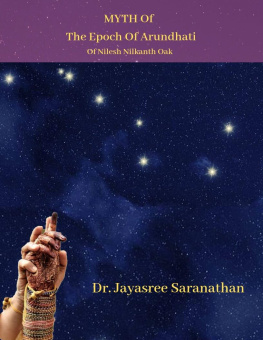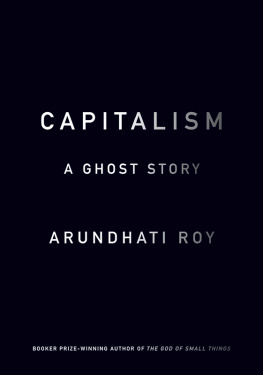Jayasree Saranathan - Myth of The Epoch of Arundhati
Here you can read online Jayasree Saranathan - Myth of The Epoch of Arundhati full text of the book (entire story) in english for free. Download pdf and epub, get meaning, cover and reviews about this ebook. year: 2019, publisher: RARE Publications, genre: Children. Description of the work, (preface) as well as reviews are available. Best literature library LitArk.com created for fans of good reading and offers a wide selection of genres:
Romance novel
Science fiction
Adventure
Detective
Science
History
Home and family
Prose
Art
Politics
Computer
Non-fiction
Religion
Business
Children
Humor
Choose a favorite category and find really read worthwhile books. Enjoy immersion in the world of imagination, feel the emotions of the characters or learn something new for yourself, make an fascinating discovery.
- Book:Myth of The Epoch of Arundhati
- Author:
- Publisher:RARE Publications
- Genre:
- Year:2019
- Rating:4 / 5
- Favourites:Add to favourites
- Your mark:
- 80
- 1
- 2
- 3
- 4
- 5
Myth of The Epoch of Arundhati: summary, description and annotation
We offer to read an annotation, description, summary or preface (depends on what the author of the book "Myth of The Epoch of Arundhati" wrote himself). If you haven't found the necessary information about the book — write in the comments, we will try to find it.
Myth of The Epoch of Arundhati — read online for free the complete book (whole text) full work
Below is the text of the book, divided by pages. System saving the place of the last page read, allows you to conveniently read the book "Myth of The Epoch of Arundhati" online for free, without having to search again every time where you left off. Put a bookmark, and you can go to the page where you finished reading at any time.
Font size:
Interval:
Bookmark:
Myth of
The Epoch of Arundhati
of Nilesh Nilkanth Oak.
Dr.Jayasree Saranathan, Ph.D (Astrology)
To
Vrihannala
MYTH OF
THE EPOCH OF ARUNDHATI
OF NILESH NILKANTH OAK.
Dr.Jayashree Saranathan
E-Book : 2019
ISBN: 978-93-83826-53-7
Published by

An Imprint of
RARE Publications
Sri Padmavathi Nivas, 2nd Floor
#2/9,Dr.Sadhasivam Street,
Thyagarayanagar, Chennai -600017
E-mail: info@rarebooksonweb.com
Website: www.rarebooksonweb.com
Laser typeset by RARE Publications , Chennai
A word of thanks to movers and helpers in bringing out this book:
I am grateful to Dr.D.K Hari and Dr. Hema Hari for being the moving force behind me, encouraging me to write this critique;
To Dr.Harish Saranathan for lending his expertise in astro-dynamics to help me deduce what really caused Vyasa to make a nuanced observation of the Arundhati-Vasishtha pair;
To Mr.P.K. Saranathan for the preparation of graphs and some illustrations used in this book;
To Mr. R.Ramanathan, the Vedic scholar, for helping me with correct meaning for Sanskrit words and verses;
To Mr.Nadathur Parthasarathy Iyengar, the marriage Purohit for explaining me the context and meaning of the Vivaha mantras for Arundhati-sighting;
To Mrs. Abhinaya Rangarajan for creating the cover-illustration;
To Mr.S. Ranganathan for formatting and publishing this book;
And most importantly, to Mr.Nilesh Nilkanth Oak whose twitter interaction with me convinced me that I must expose the absurdity of his so-called Epoch of Arundhati.
Purva Paksha
Uttara Paksha
Evidence from Aihole Inscription
I never knew that dating an historical event can be so easy until I read the book When Did The Mahabharata War Happen? The Mystery of Arundhati written by Nilesh Nilkanth Oak. All that you need to do is to get fascinated by an astronomy observation that you read for the first time in the University library and think you have comprehended it, check the works of others and pick out the one that sounds more like yours, buy astronomy books and star catalogues to acquaint yourself with the terms and basic concepts and run the simulator at regular intervals to see what you thought appears in the screen no matter what it could mean in astronomy. If you catch up a scenario that you are looking for on a select window of the simulator that is eureka moment for you and with that you can claim yourself a revolutionary like Copernicus, Kepler and Galileo!
The kind of impression as above that one gets on reading this book is quite disturbing for the reason that the research constructed in this way and trumpeted as one based on scientific acumen and logical reasoning by the author himself is in effect questioning the very basics of two issues of importance to the Hindu society. His entire research is aimed at proving that the iconic characterisation of Arundhati is indeed wrong. She as one following the steps of her husband Vasishtha still continues to be invoked in Vedic mantras in the Hindu marriages, and his research renders this practice ridiculous. His theory, if accepted would amount to dismantling the iconic status of Arundhati in the Hindu society.
The other issue pertains to the date of Mahabharata war deduced by Oak in his book which is a contravention to the current system of time keeping. Everyday millions of times in this country, the current time is being invoked in the Sankalpa mantras from the beginning of Kali Yuga that started 5120 years ago at the time of writing this. His book has created a piquant situation that if his date is right it means the present age of Kali Yuga is wrong and with that the alignment of week day and the solar year would also be wrong for the very reason that these two are intertwined and the week day used all over the world today is calculated from the first day of the Kali Yuga that started 5120 years ago.
By discrediting a cultural symbol of our society and destabilising the foundation of time keeping, Nilesh Oaks research throws a disturbing and a serious challenge to the very basis of the Hindu society which is still functioning on the formulations given by the Vedic sages of yore. His research throws a challenge to the ingenuity of the Vedic sages for elevating Arundhati perennially to the celestial sphere much like Dhruva, the son of Uttanapada.
Nilesh Nilkanth Oaks research is based on a single verse of sage Vyasa told to Dhritarashtra just before the commencement of the Mahabharata war expressing a deviation in the usual appearance of the binary, Vasishtha and Arundhati (Mizar and Alcor) in the Ursa Major constellation identified as Saptarishi constellation by the Vedic society. The binary is always seen as though the star Arundhati is towing behind the star Vasishtha much like the real character Arundhati who always followed her husband Vasishtha. At the time of Mahabharata war, sage Vyasa has made a statement that Arundhati kept Vasishtha at her back phata kta .
This expression has been taken by Nilesh Oak as scientifically testable one, or to use his word from Karl Poppers terminology, falsifiable one. He has checked the position of these two stars in a select window of the latest version of Voyager software and made the claim that Arundhati walked ahead of Vasishtha for more than 6000 years and has named that period as the Epoch of Arundhati. Since the observation of Arundhati walking in front of Vasishtha was reported by Vyasa, Oak hypothesises that Mahabharata could have happened only within the Epoch of Arundhati. And in the absence of such an observation, Ramayana must have happened before the Epoch of Arundhati, according to him. Picking out the other astronomy references in Mahabharata and fitting them within this Epoch using his Voyager simulator, he has identified the year 5561 BCE as the year of Mahabharata war. This is clearly far earlier than the traditional date of Mahabharata by more than 2000 years!
It is not an understatement that an average Hindu who believes in the symbolism of Arundhati and the Hindu time scale is anguished by these ideas promoted as having passed scientific and empirical tests. Therefore the need arises to put into test his ideas and the methods he has used to push these ideas. Basically this can be re-phrased into two questions:
(1) Did Arundhati walk ahead of Vasishtha?
(2) Did Nilesh Oak use a reliable methodology of research?
There is absolutely no indication anywhere in his book, or in his blogs and videos released until the time of writing this, that Nilesh Oak ever thought about the conflict with the symbolism of Arundhati that his research is creating. There can be no denial of the fact that he began his research on Arundhati with no idea of who she was and what she stood for and why a star was named after her. He was attracted to Arundhati observation for a simple reason - to quote his words, I could understand it and I felt it, naively so, that I could easily test it . Let him test it, but test he must after logically deriving the concept or conceptually explaining the idea or mathematically working on the idea wherever required. Only after getting a concept or the numbers derived in different methods should one test it in the simulator. The simulator or software should endorse the findings but not be used as the sole means of giving an output which one wants to see.
His book reveals that his research into dating the Mahabharata war was not methodical but one that was based on checking different simulators until he got what he wanted to see. Once after he got it from the simulator, everything else was corroborated including the methodology that he is vociferously boasting out in his videos and blogs but scarcely mentioned in his book.
Font size:
Interval:
Bookmark:
Similar books «Myth of The Epoch of Arundhati»
Look at similar books to Myth of The Epoch of Arundhati. We have selected literature similar in name and meaning in the hope of providing readers with more options to find new, interesting, not yet read works.
Discussion, reviews of the book Myth of The Epoch of Arundhati and just readers' own opinions. Leave your comments, write what you think about the work, its meaning or the main characters. Specify what exactly you liked and what you didn't like, and why you think so.












